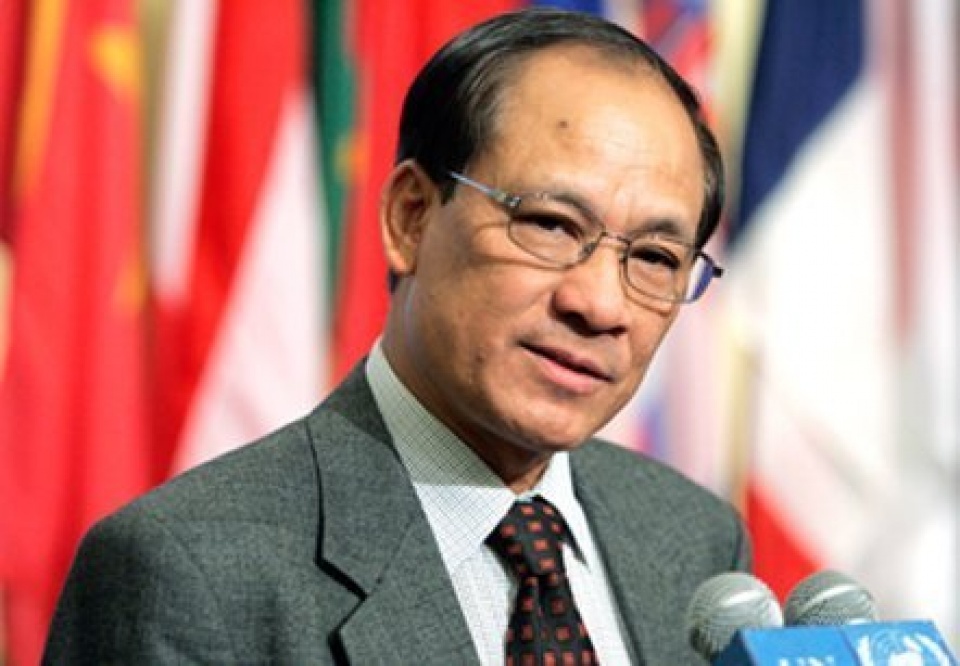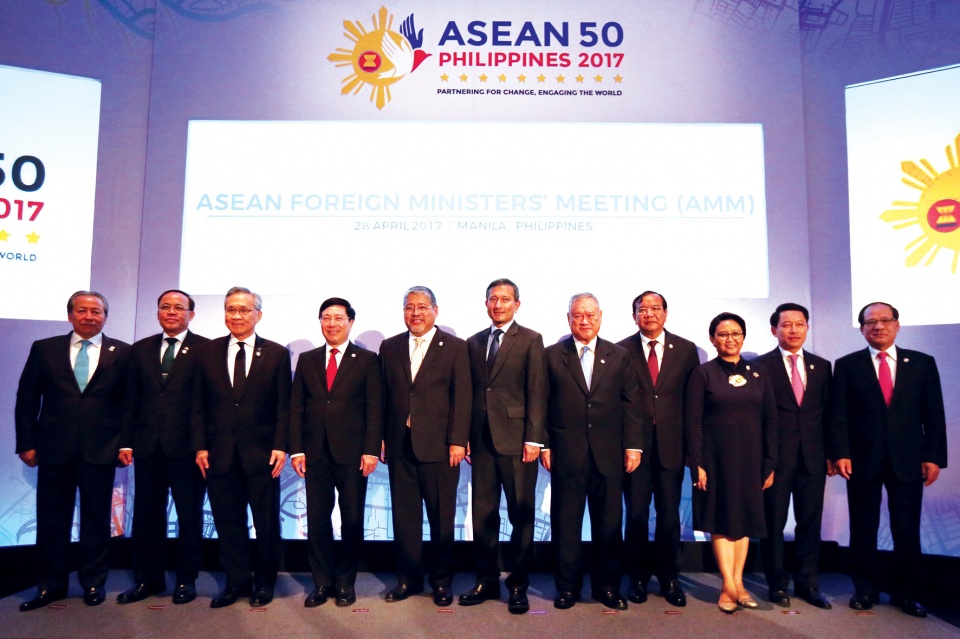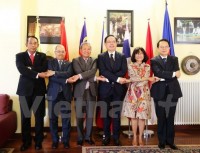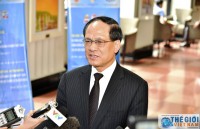
ASEAN at 50 and beyond: AEC for a Resilient, People-Centred ASEAN
Latest
| TIN LIÊN QUAN | |
| PM Nguyen Xuan Phuc greets ASEAN Secretary-General | |
| Vietnam attends seminar on ASEAN-Latin America relations | |
Following the formal establishment of the ASEAN Community, including the ASEAN Economic Community (AEC) at the end of 2015, ASEAN has embarked on a new phase of regional integration in this fast changing context. The early signs of growth spurts, after long years of slow economic recovery, remain feeble and uncertain. The Association needs to maneuver its way to achieve the ASEAN Community Vision 2025. This requires our policymakers to be far-sighted, adaptive and resilient.
Looking back to the time when the Bangkok Declaration was signed for the establishment of ASEAN in 1967, the region has come far. ASEAN has evolved and expanded from a five-member association to a ten-member community to fulfill its vision of uniting all nations of Southeast Asia under one roof. Overcoming the challenges in the course of its evolution and development over the past 50 years and through a decades-long process of Community building, ASEAN has fundamentally shaped the regional agenda and become one of the most successful regional organizations. With a current combined GDP of approximately 2.6 trillion USD, ASEAN collectively is the 6th largest economy in the world.
 |
| Secretary-General of ASEAN Le Luong Minh - Author of the article. (Photo: UN) |
It is also the world’s 4th largest trade power house and a preferred investment destination. Economic activities yield vast income and generate vast employment. These economic achievements have far reaching implications on the people’s well-being as health and education spending increases with income.
The proportion of people living below the national poverty lines has been halved in the past two decades. ASEAN infant mortality ratio today is only a third compared to 1990’s. The net enrolment rate of primary school age is now at about 96%. Relative peace and security has been maintained. A relatively young demographic with more than half of its population younger than 30 years old will continue to support the region’s positive trajectory.
Challenges still remain
The challenges ahead of ASEAN in its continued process of Community building and integration, however, are not small. Some of the more developed ASEAN member states will start to face the impacts of aging populations, while some are working to overcome the middle income trap. Others struggle to move from cost-based to value-based competitiveness.
Governments in the region are also grappling with rising inequality and adapting to the digitzation of their economies. Non-traditional threats such as uncontrolled migration, radicalism and trans-boundary crimes are also becoming more pronounced. As economies become more interconnected, problems too become increasingly globalized.
For such challenges, effective solutions cannot be formulated in silos, but require coordination, cooperation and a broader outlook. What stands out the most from the current phenomenon is that globalization – long taken as irreversible – is now under threat from their traditional strongest proponents. For a region so deeply embedded in global value chains, a threat on globalization and free trade cannot be taken lightly.In this connection, at least two lessons can be learned for ASEAN’s regional economic integration agenda:
First, public perception matters. What is happening in the emerging discourse on globalization and free trade was at least partially brought about by public misperception on what is the cause of their domestic situation, from unemployment, underemployment to inequality. This highlights the importance of effective outreach and communication to raise awareness, promote understanding and correct misperceptions about its integration agenda. Regional integration is neither a panacea nor a cause for manifold domestic issues. Basic understanding of what regional integration entails, and what it does not, needs to reach the stakeholders. Continuous efforts must be made to communicate relevant information to all stakeholders.
Second, for regional integration to be sustainable, it needs to be inclusive and to deliver meaningful benefits to the stakeholders. This is only possible through a consultative and participatory process both in the development and the implementation of the agenda. ASEAN has taken a step forward by strengthening its monitoring and evaluation of the implementation of the ASEAN Community Blueprints, in which it will be going beyond tracking implementation progress to also look at the outcomes and impacts of implemented measures on the stakeholders. Impact evaluation will be further strengthened with stakeholder feedback mechanisms.
 |
| ASEAN Community. (Photo: Jakarta Post) |
As much as what has been achieved over 50 years of its regional integration, challenges remains for ASEAN along the way: in maintaining ASEAN centrality and preserving the region’s stability in the face of external shocks; in rebalancing global power dynamics; in translating the commitments into national legal and policy frameworks; in ensuring compliance and enforcement; in Community identity-building across diverse nations; and, in coming up with collaborative solutions to address common problems.
The formal establishment of the ASEAN Community at the end of 2015 and the adoption of the ASEAN Community Vision 2025 and its three corresponding Community Blueprints were testament to the region’s continued commitment to its integration agenda. Three perspectives stand out in ASEAN’s economic integration agenda towards AEC 2025, which showcased ASEAN’s readiness in facing the current developments:
First is a renewed focus on people in line with ASEAN’s broader vision of a rules-based, people-centered, people-oriented ASEAN.
Second is a forward-looking approach in recognition of the dynamic context in which regional integration is set and in line with the objective of ensuring a sustainable regional integration agenda.
Third is the recognition of a holistic approach to regional integration by promoting inter-pillar and cross-sectoral coordination.
The fourth characteristic of the AEC Blueprint 2025 on being people-focused refers to a Resilient, Inclusive, People-Oriented, and People-Centred ASEAN and comprises of five cooperation areas namely: strengthening the role of micro, small and medium enterprises; strengthening the role of the private sector; public private partnership; narrowing the development gap; and, stakeholder contribution to regional integration efforts.
Efforts have been focused not only on deepening existing initiatives but alsoexpanding the agenda on MSMEs and narrowing development gaps. Beyond MSME development and capacity building, specific efforts on supporting the internationalization of MSMEs and their participation in global value chains have been made through initiatives on increasing access to finance and improving business registration processes. Concrete initiatives are now in place in an effort to institutionalize direct private sector engagement in ASEAN’s economic integration agenda.
On being forward-looking, the AEC Blueprint 2025 incorporates new elements that reflect ASEAN awareness and readiness to embrace the rapidly changing global and regional contexts from electronic commerce to sustainable economic development. The introduction of these new elements reflects ASEAN’s vision on the need to develop lasting competitiveness by continuing to innovate, to integrate and grow in a sustainable manner, and to take into consideration and embrace new opportunities presented by global megatrends.
The AEC Blueprint 2025 reflects ASEAN’s recognition that innovative capacity is a source of lasting competitive advantage, and governments have a role to play in creating an enabling environment for people to innovate, to adopt existing technologies and innovation, and to incentivize technology commercialization and that innovation is not the exclusive domain of big multinational enterprises and companies but that all elements of the market should be encouraged to partake and create new values.
ASEAN is also embracing the digitization of the economy, and in particular recognizes the importance of economies to be ready to engage and facilitate electronic commerce. The region’s participation rate in electronic commerce has rapidly increased withthe emergence of local e-commerce platforms and the participation of MSMEs in e-commerce. With electronic commerce given a renewed emphasis, ASEAN has taken concrete steps in this direction by establishing the ASEAN Coordinating Committee on Electronic Commerce and finalizing the ASEAN Work Programme on Electronic Commerce within this year.
The pursuit of economic growth shall not come at the expense of sustainability. In the development of its Community Vision 2025 and in the early stage of its implementation, ASEAN has focused on ensuring the complementarity between the United Nations 2030 Agenda for Sustainable Development and ASEAN Community building efforts. The AEC Blueprint 2025 therefore includes an element on sustainable economic development, which focuses on food security and sustainable agriculture, as well as on having a more sustainable energy mix, including through the use of renewable energy.
Last but not least, the new AEC Blueprint has also taken into consideration global megatrends which are commonly defined as large, transformative global forces that have profound impact on business, economies, industries, societies and individuals. ASEAN recognizes that as it is integrating more into the global economy, the region will also be significantly impacted by these megatrends in coming decades. It is therefore vital for ASEAN to recognize their importance and implicationscapitalize on the opportunities presented and prepare to address the associated challenges in progressing its regional integration agenda.
The impact of economic integration must not be viewed only from economic but more comprehensive perspectives. We have seen how public disappointment of certain economic outcomes may cause social instability and even political adjustment. To this end, inter-pillar and cross-sectoral platforms must be best used for discussions and required action.
 |
| ASEAN could be the world's fourth largest economy by 2050. (Photo: AFP) |
A bright future
It has been estimated that if ASEAN is able to maintain its growth momentum, it will be the world’s fourth largest economy by 2050. The region has so much potential to be a stronger, more influential actor in the global economy. Efforts have been focused not only on deepening existing initiatives but also by expanding the agenda. Already now, as the tide is turning against globalization and free trade, ASEAN is seen as the beacon of open regionalism. The Regional Comprehensive Economic Partnership (RCEP) was first initiated by ASEAN in 2011 aims to achieve a modern, comprehensive, high-quality and mutually beneficial agreement.
Successfully concluded the RCEP will be among the world’s largest trading blocs, covering almost half of the world population and more than a third of global trade and output. Beyond the RCEP, ASEAN will further strengthen its global engagement with its FTA partners and beyond. It is currently negotiating an FTA with Hong Kong. It is also studying possibilities of FTAs with the Eurasian Economic Union and Canada.
ASEAN remains a strong supporter of the multilateral trading system, recognizing the importance of a non-discriminatory, rules-based, transparent trading system in providing the much needed business certainty that would facilitate further development of global value chains. ASEAN will continue to embrace globalization, free trade and open regionalism. ASEAN remains committed to its regional integration and for all of these to be sustainable, the Community will continue to put the people back to the core of the agenda.
Le Luong Minh
Secretary-General of ASEAN
 | Vietnam promotes ASEAN’s role in Italy The Embassy of Vietnam has fulfilled its missions of increasing the role and position of ASEAN in Italy while chairing the ASEAN Committee in Rome ... |
 | Sports exchange to mark 50th anniversary of ASEAN The Ministry of Foreign Affairs organized a sports exchange themed 'ASEAN Golden Games' at the Indoor Athletics Palace in Ha Noi on July 22. |
 | Vietnam helps boost ASEAN’s development: ASEAN Secretary General Vietnam has an important role in fostering the development of the Association of Southeast Asian Nations (ASEAN), affirmed ASEAN Secretary General Le Luong Minh. |

















